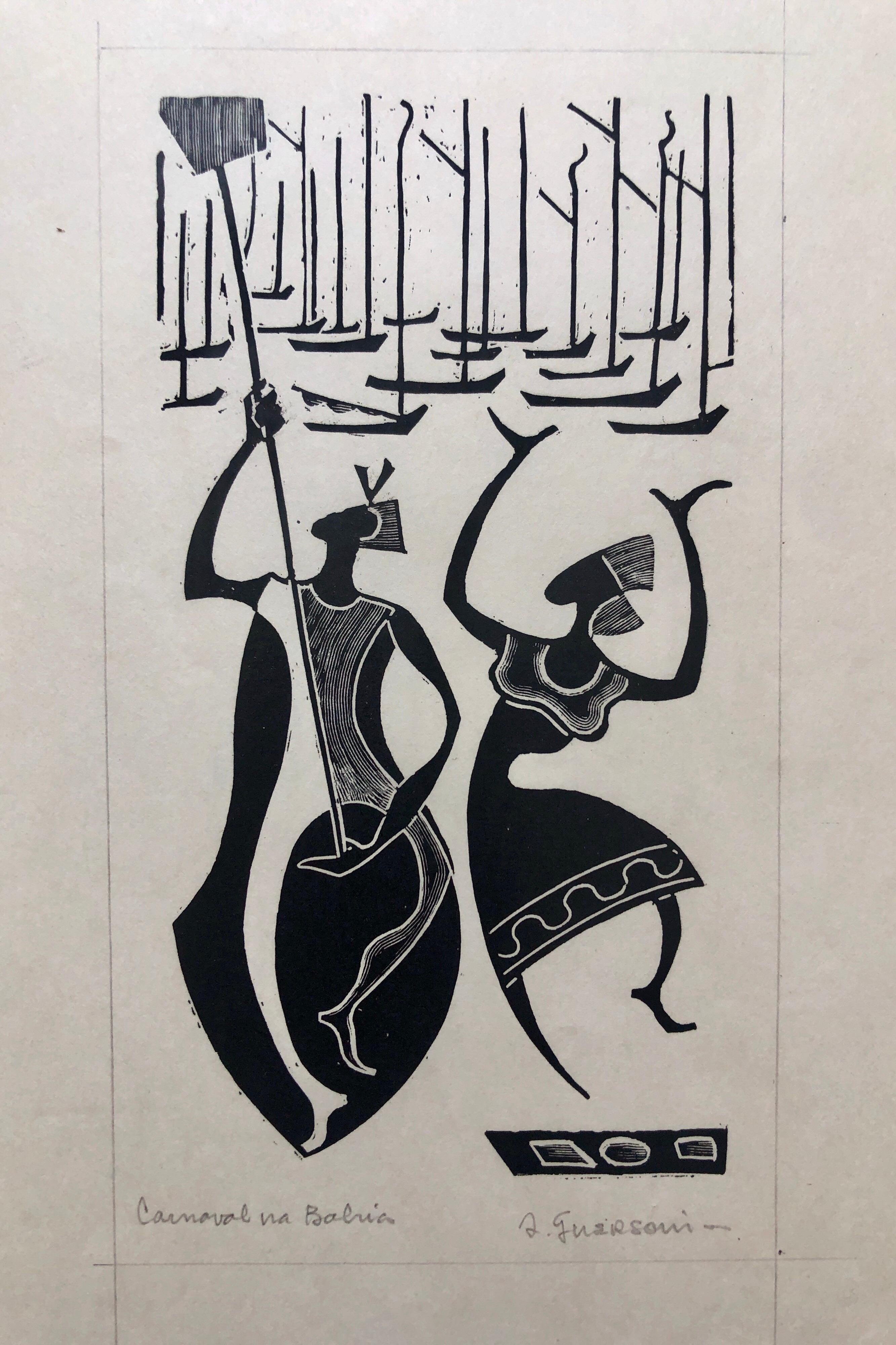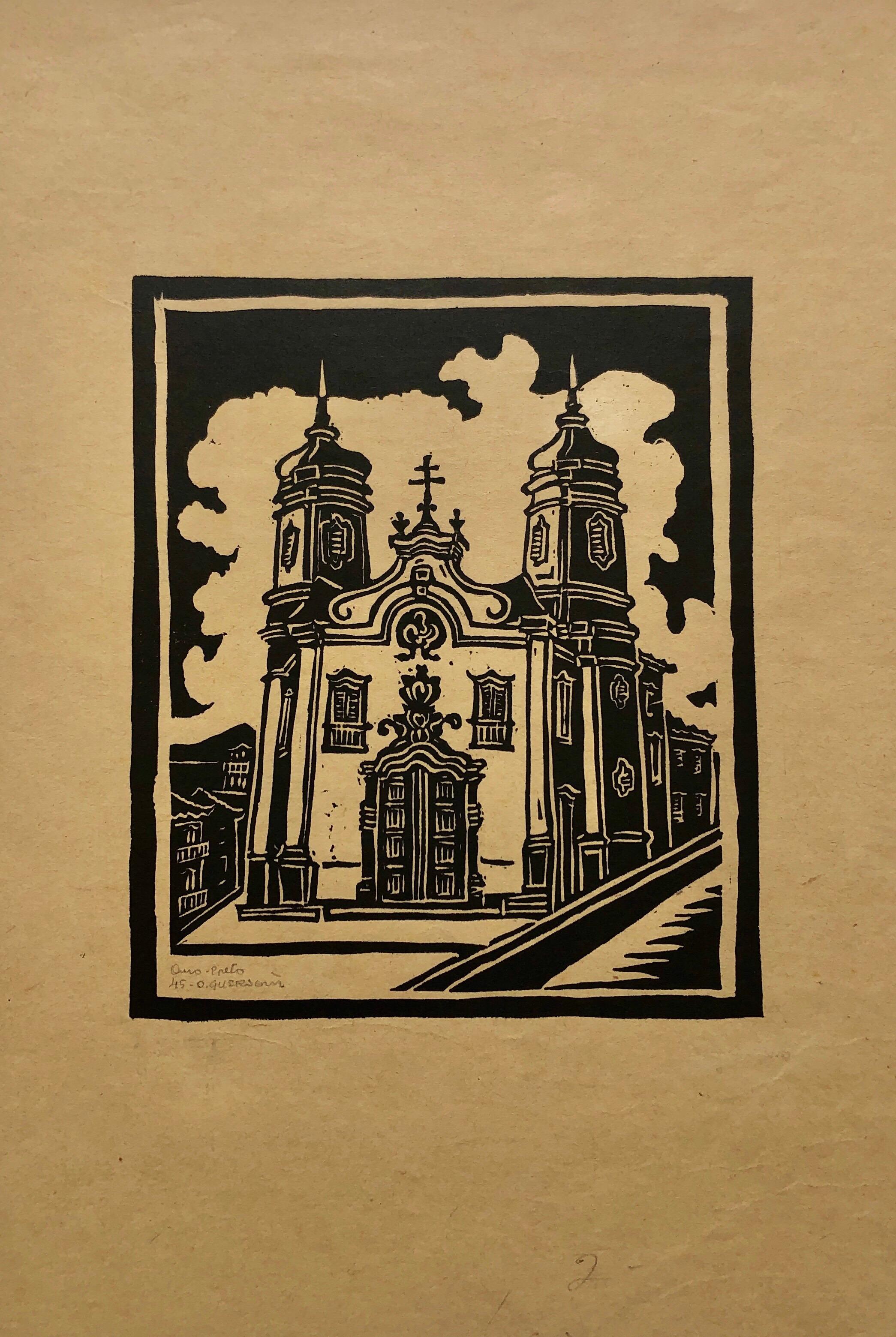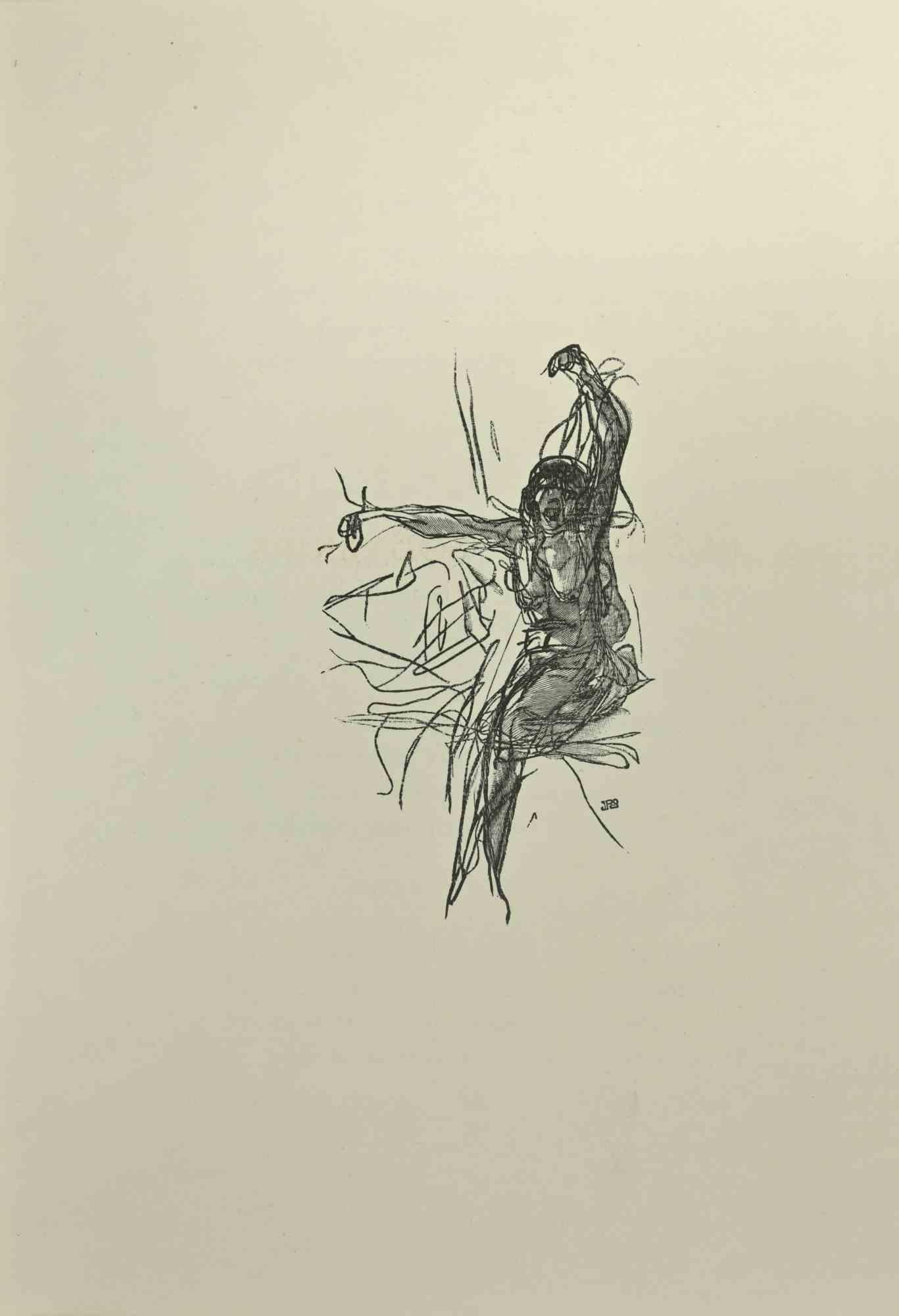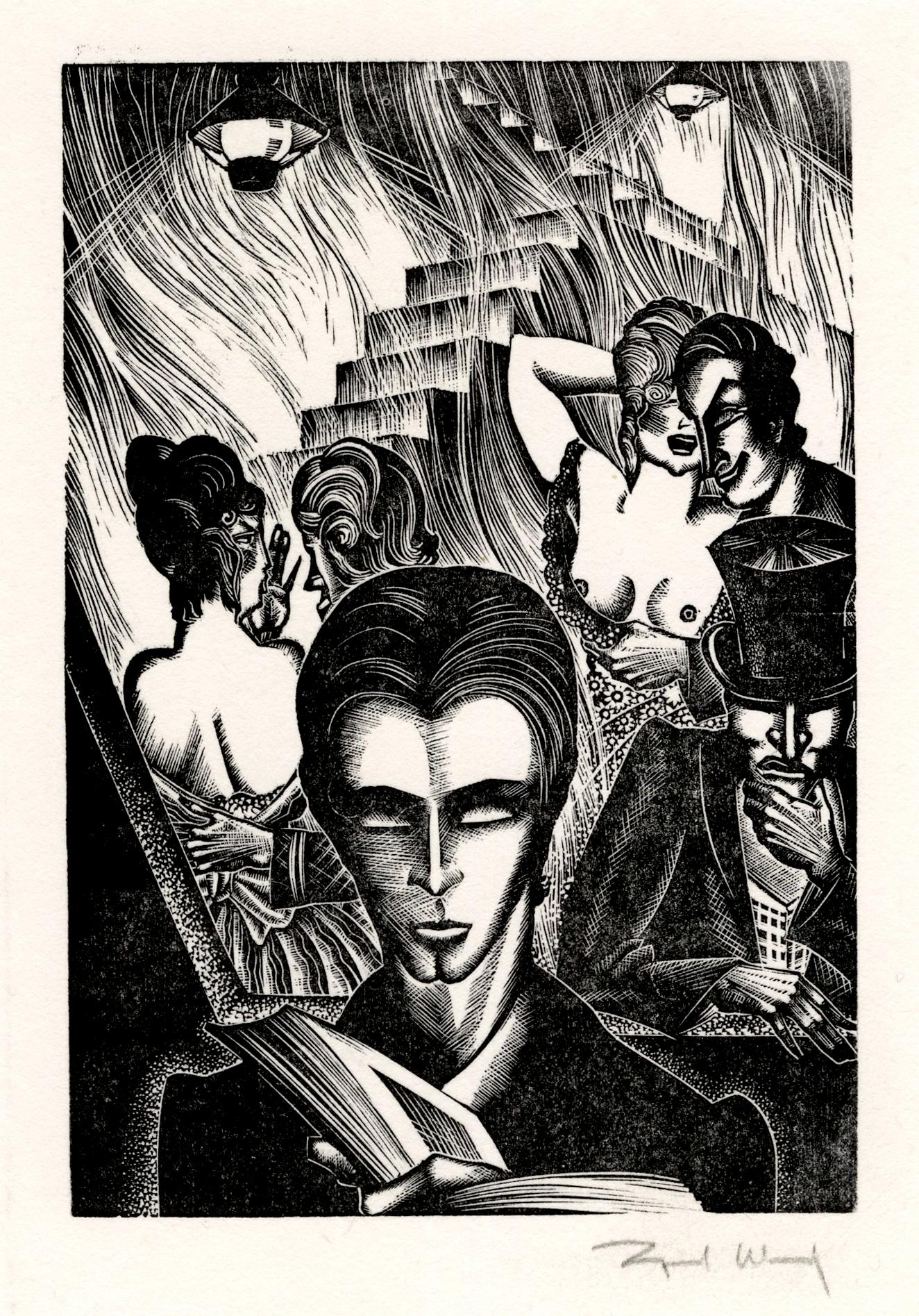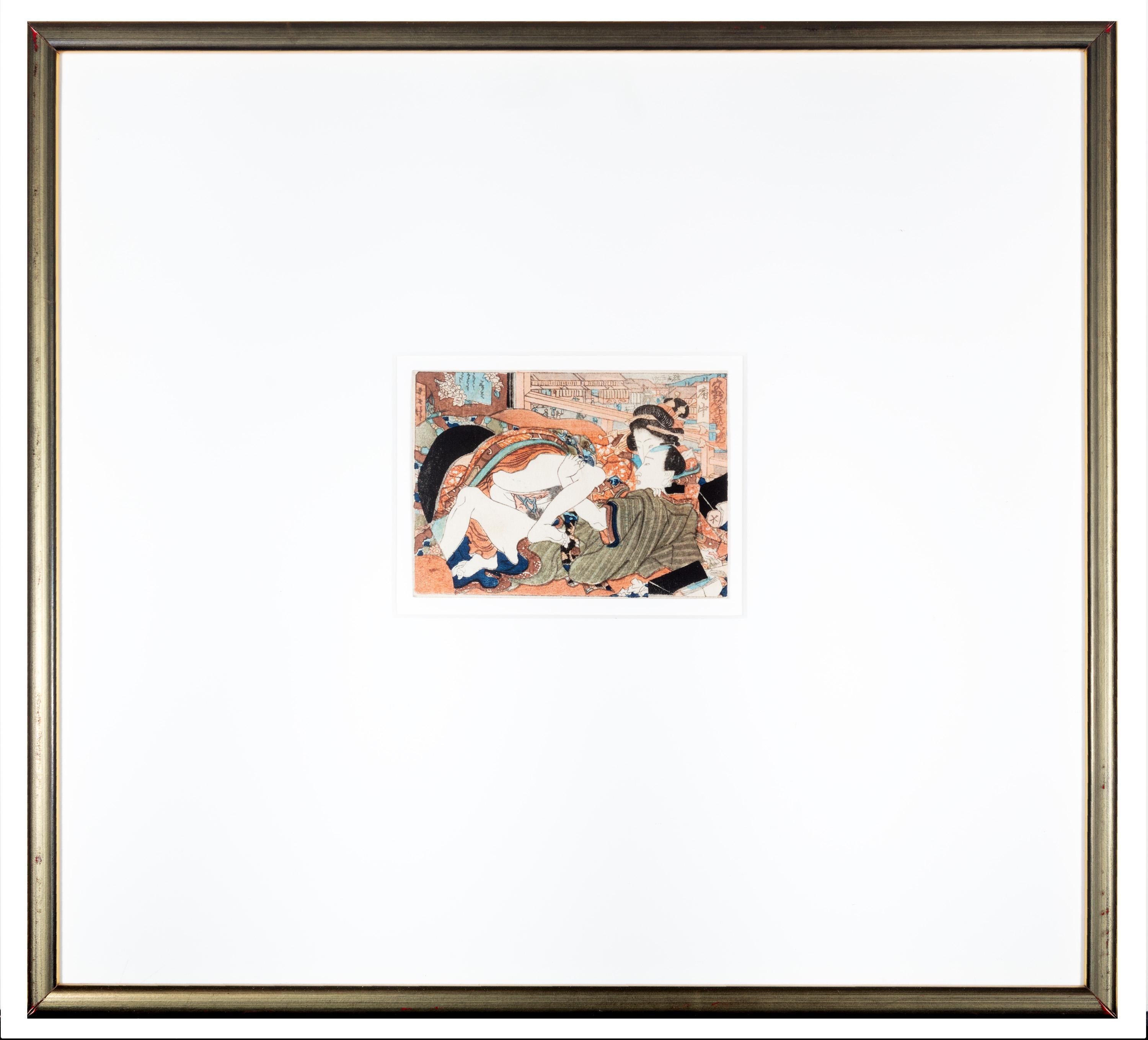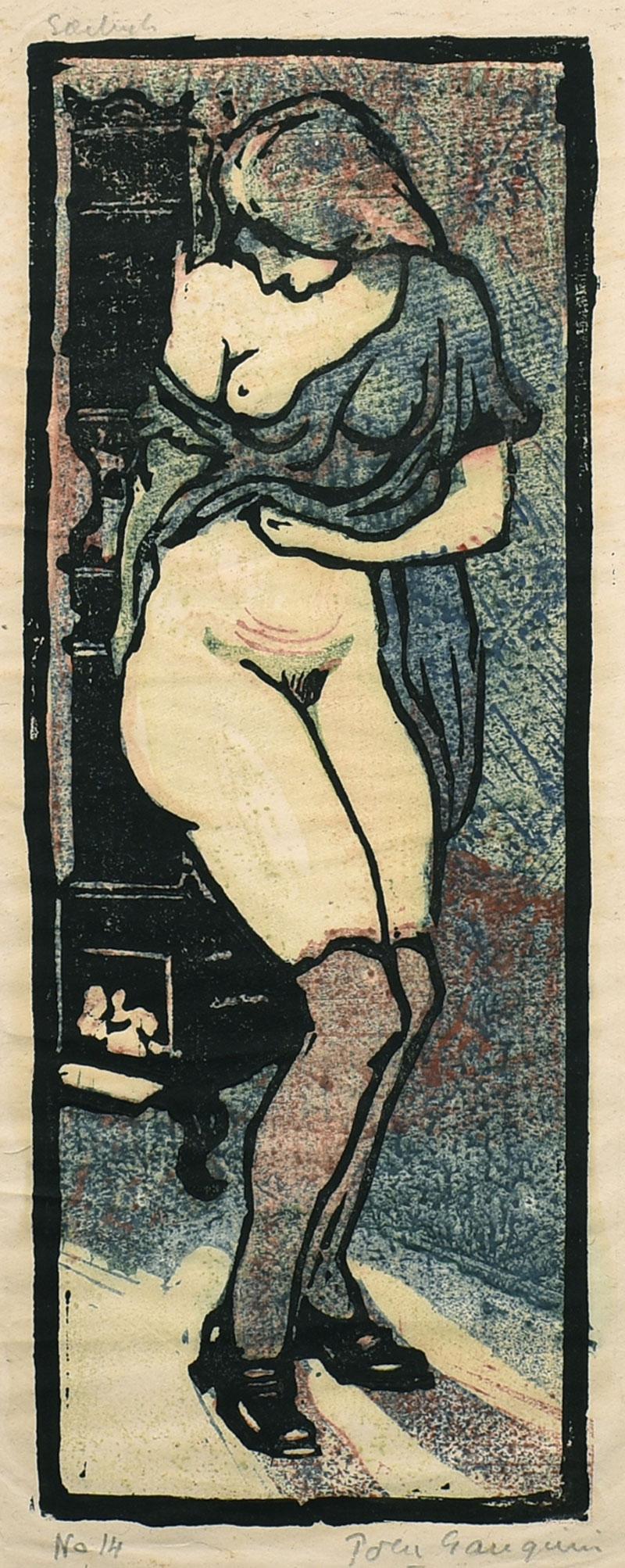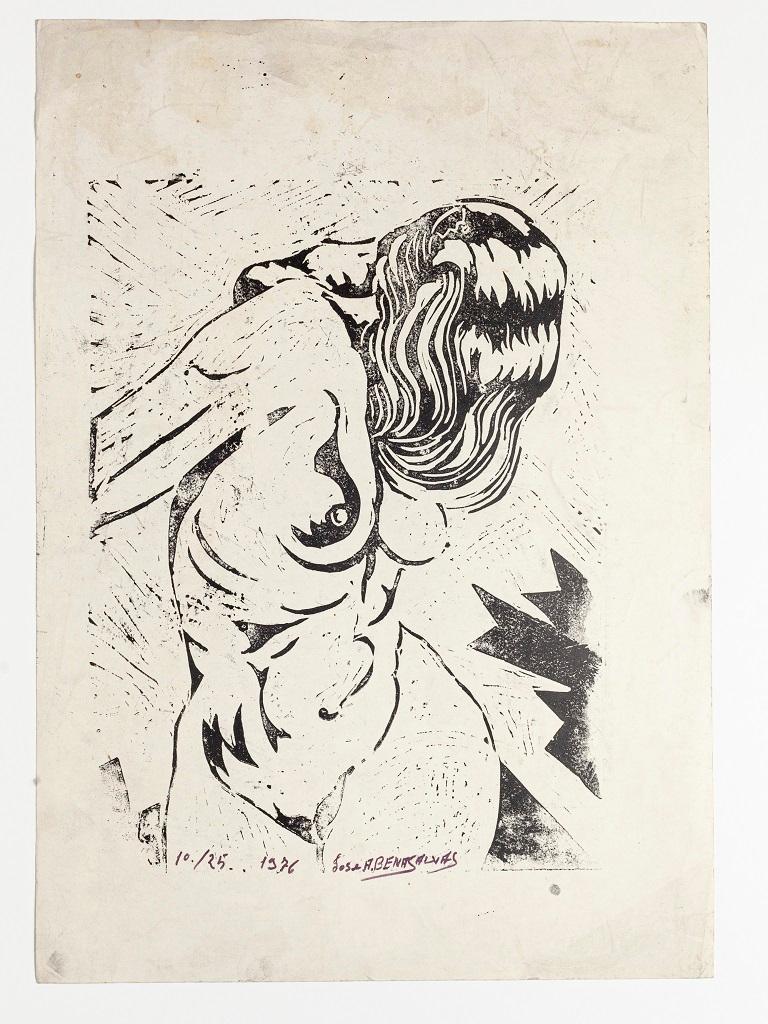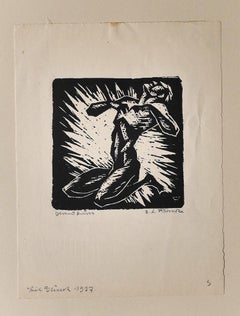Tahiti
View Similar Items
Want more images or videos?
Request additional images or videos from the seller
1 of 9
Wolfgang WolffTahiti1940
1940
About the Item
- Creator:Wolfgang Wolff (1909 - 1994)
- Creation Year:1940
- Dimensions:Height: 21.75 in (55.25 cm)Width: 18 in (45.72 cm)Depth: 1 in (2.54 cm)
- Medium:
- Period:
- Condition:
- Gallery Location:San Francisco, CA
- Reference Number:Seller: wolff/tahiti/pap/031stDibs: LU66635115911
About the Seller
5.0
Platinum Seller
These expertly vetted sellers are 1stDibs' most experienced sellers and are rated highest by our customers.
Established in 1999
1stDibs seller since 2017
685 sales on 1stDibs
Typical response time: 1 hour
More From This SellerView All
- TahitiBy Wolfgang WolffLocated in San Francisco, CAThis artwork titled "Tahiti" 1941 Is a original woodcut by noted French/German artist Wolfgang Wolff, 1909-1994. It is hand signed in pencil by the artist at the lower right corner, ...Category
Mid-20th Century Realist Figurative Prints
MaterialsWoodcut
- Torso de Joven (Torso de Jeune Fille)By Rufino TamayoLocated in San Francisco, CAThis artwork titled "Torso de Joven (Torso de Jeune Fille)" from the suite "The Mujeres File" 1969 is an original colors lithograph on Wove paper by renown Mexican artist Rufino Tama...Category
Mid-20th Century Modern Figurative Prints
MaterialsLithograph
- Torso de MujerBy Rufino TamayoLocated in San Francisco, CAThis artwork titled "Torso de Mujer (Torso de Femmee)" from the suite "The Mujeres File" 1969 is an original colors lithograph on Wove paper by renown Mexican artist Rufino Tamayo, 1899-1991. It is hand signed and inscribed H.C. (Hors Commerce) in pencil by the artist. The image size is 26.85 x 21 inches, framed size is 40.75 x 33 inches. Published by Touchtone Publisher, New York, printed by Ateliers Desjobert, Paris. Referenced and pictured in the artist's catalogue raisonne by Pereda, plate #108 page 107. Custom framed in a wooden gold frame, with gold bevel and light beige fabric matting. It is in excellent condition. About the artist: A native of Oaxaca in Southern Mexico, Rufino Tamayo's father was a shoemaker, and his mother a seamstress. Some accounts state that he was descended from Zapotec Indians, but he was actually 'mestizo' - of mixed indigenous/European ancestry. (Santa Barbara Museum of Art). He began painting at age 11. Orphaned at the age of 12, Tamayo moved to Mexico City, where he was raised by his maternal aunt who owned a wholesale fruit business. In 1917, he entered the San Carlos Academy of Fine Arts, but left soon after to pursue independent study. Four years later, Tamayo was appointed the head designer of the department of ethnographic drawings at the National Museum of Archaeology in Mexico City. There he was surrounded by pre-Colombian objects, an aesthetic inspiration that would play a pivotal role in his life. In his own work, Tamayo integrated the forms and tones of pre-Columbian ceramics...Category
Mid-20th Century Modern Figurative Prints
MaterialsLithograph
- La Negra (The Black Woman)By Rufino TamayoLocated in San Francisco, CAThis artwork titled "La Negra (The Black Woman)" from the suite "The Mujeres File" 1969 is an original colors lithograph on B.F.K. Rives paper by renown Mexican artist Rufino Tamayo, 1899-1991. It is hand signed and numbered 150/150 in pencil by the artist. The image size is 26.85 x 21.25 inches, sheet size is 29.5 x 22.15 inches, framed size is 42 x 35 inches. Published by Touchtone Publisher, New York, printed by Ateliers Desjobert, Paris. Referenced and pictured in the artist's catalogue raisonne by Pereda, plate #109 page 107. Custom framed in a wooden silver frame, with silver spacer and fabric matting. It is in excellent condition. About the artist: A native of Oaxaca in Southern Mexico, Rufino Tamayo's father was a shoemaker, and his mother a seamstress. Some accounts state that he was descended from Zapotec Indians, but he was actually 'mestizo' - of mixed indigenous/European ancestry. (Santa Barbara Museum of Art). He began painting at age 11. Orphaned at the age of 12, Tamayo moved to Mexico City, where he was raised by his maternal aunt who owned a wholesale fruit business. In 1917, he entered the San Carlos Academy of Fine Arts, but left soon after to pursue independent study. Four years later, Tamayo was appointed the head designer of the department of ethnographic drawings at the National Museum of Archaeology in Mexico City. There he was surrounded by pre-Colombian objects, an aesthetic inspiration that would play a pivotal role in his life. In his own work, Tamayo integrated the forms and tones of pre-Columbian ceramics into his early still lives and portraits of Mexican men and women. In the early 1920s he also taught art classes in Mexico City's public schools. Despite his involvement in Mexican history, he did not subscribe to the idea of art as nationalistic propaganda. Modern Mexican art at that time was dominated by 'The Three Great Ones' : Diego Rivera, Jose Clemente Orozco, and David Alfaro Siqueros, but Tamayo began to be noted as someone 'new' and different' for his blending of the aesthetics of post Revolutionary Mexico with the vanguard artists of Europe and the United States. After the Mexican Revolution, he focused on creating his own identity in his work, expressing what he thought was the traditional Mexico, and refusing to follow the political trends of his contemporary artists. This caused some to see him as a 'traitor' to the political cause, and he felt it difficult to freely express himself in his art. As a result, he decided to leave Mexico in 1926 and move to New York, along with his friend, the composer Carlos Chavez. The first exhibition of Tamayo's work in the United States was held at the Weyhe Gallery, New York, in that same year. The show was successful, and Tamayo was praised for his 'authentic' status as a Mexican of 'indigenous heritage', and for his internationally appealing Modernist aesthetic. (Santa Barbara Museum of Art). Throughout the late thirties and early forties New York's Valentine Gallery gave him shows. For nine years, beginning in 1938, he taught at the Dalton School in New York. In 1929, some health problems led him to return to Mexico for treatment. While there he took a series of teaching jobs. During this period he became romantically involved with the artist Maria Izquierdo...Category
Mid-20th Century Modern Figurative Prints
MaterialsLithograph
- "Woman With Whip and Leather" from the suite "Bad Girls"By Charles BraggLocated in San Francisco, CAThis artwork titled "Woman With Whip and Leather" from the suite "Bad Girls". c.1990 is an original color seigraph on Somerset Archival paper by noted ...Category
Late 20th Century Other Art Style Nude Prints
MaterialsScreen
- Crimson DreamsLocated in San Francisco, CAThis artwork titled "Crimson Dreams" c.2000 is an original color serigraph with gold addition by British artist Peter Nixon, b.1956. It is hand signed and ...Category
21st Century and Contemporary Realist Figurative Prints
MaterialsScreen
You May Also Like
- Suffering- Original Woodcut on Paper by Erikma Lawson Frimke - 1937By Erikma Lawson FrimkeLocated in Roma, ITSuffering is an original woodcut artwork on paper realized in 1937 by Russian artist Erikma Lawson Frimke (1878-1956), Hand-signed and dated on the lower in pencil. The state of pre...Category
1930s Modern Figurative Prints
MaterialsWoodcut
- 1945 Brazilian Master, Art Deco Nudes Serigraph Woodcut Carnaval BahiaBy Odetto GuersoniLocated in Surfside, FLGenre: Brazilian Art Deco, African Diaspora Bahian Carnival Subject: Abstract Medium: Print Surface: Paper Country: Brazil Dimensions of overall paper are listed. This is from a series of work he did in the 1940's, we sold one called Ritmo Negro, they are about Afro-Brazilian jazz, dance and music. Odetto Guersoni was born in the city of Jaboticabal, State of São Paulo, in 1924. From 1936 to 1941 he attended the Liceu de Artes de Ofícios in São Paulo, beginning his artistic career in 1945, when he exhibited paintings in the Hall of the Plastic Artists Union . Two years later he was part of the collective group of 19, alongside Aldemir, Charoux, Otavio Araújo, Grassmann, Maria Leontina and several other artists that time would make famous. He then practiced a figurative painting of accentuated Expressionist lauds, characterized by deformation and coloring, raw and Satirical- as, moreover, so many of his fellow exhibitors at the time. As a French government scholar, Odette Guerzoni went to Paris in 1947 and the following year took part in the Peintres et Graveurs Etrangers and Art Libre exhibitions. Student of engraving by Renê Cottet, gradually transformed this expressive medium into his favorite, to the detriment of painting, which he practically abandoned soon after. In 1947, he participated in the 19 Painters exhibition at the Prestes Maia Gallery together with Lothar Charoux, Maria Leontina,Grassmann, Aldemir Martins, Luiz Sacilotto and hiró. Guersoni was awarded a scholarship by the French government, and traveled to Paris, where he began work in engraving. Back in Brazil, in 1951, he founded the Art Workshop, in São Paulo. In 1954, he returned to Europe for a year, financed by the International Labor Organization (ILO). In Geneva, he studied engraving with René Cottet (1902 - 1992) and worked in Stanley william Hayter's studio, Atelier 17, in Paris (1901 - 1988). From 1956 to 1957, he became director of the Union of Plastic Artists of São Paulo. From 1960, he attended, as a trainee, some art schools in the United States and Japan such as The New York School of Printing and Osaka University. In 1971, also in Japan, he attended the workshop of I. Jokuriti. Two years later, he was voted Best Recorder of the Year by the Paulista Association of Art Critics - APCA. He took part in a special room at the Ibero-American Biennial in Montevideo in 1983. The Pinacoteca do Estado de São Paulo - Pesp presents a retrospective of his work in 1994. Odetto Guersoni explores the wide spectrum of possibilities of the engraving. In addition to using techniques such as metal etching, lithograph, serigraph, linocut and, especially, woodcut he developed, in the 1950s, the philigraphy, in which the forms he developed gained points of embroidery made by Bonadei (1906 - 1974) . And, in the 1960s, the plastigraphy, in which he makes engravings on pasty surfaces, obtained from gypsum or other soft material. In the 1970s, technical investigations were associated with pictographic, ideographic, archaic symbol searches, Brazilian cave paintings and plant forms. The drawings are reduced to stylized, geometric shapes and transformed into abstract graphic elements. The artist works with few matrices, which, organized in rectangles, squares or circles, become modules to be combined. Guersoni juxtaposes them, adds, changes colors, and thereby composes colorful mandalas and structural geometries. Based on concise compositions, it produces color vibrations through optical illusions. In many of his woodcut works of the 1980s he uses smooth wood, knives, saws, gouges, punches, avoiding the natural textures of wood. In printing, it leaves the vibrant color and employs dosed inks with colorless masses, obtaining transparencies by superpositions. New journeys of study and specialization in engraving techniques took him in 1954 to Switzerland, 1960 to the United States, and in 1966 to Germany and Austria. Today, after having performed more than 40 individuals including 16 abroad and having participated in more than 50 collectives in several countries, Guersoni is considered one of the most notable Brazilian engravers. Conquered awards in several shows. CHRONOLOGY Individual exhibitions 1946 - Sao Paulo SP - 10th Salon of the Artists' Union, at the Prestes Maia Gallery 1947 - São Paulo SP - 19 Painters, at the Prestes Maia Gallery 1948 - Paris France - Peintres et Graveurs Etrangers at the École des Beaux-Arts 1949 - São Paulo SP - 13th Salon of the Artists' Union, at the Prestes Maia Gallery 1951 - São Paulo SP - 1st Paulista Salon of Modern Art, at Prestes Maia Gallery - silver medal 1953 - São Paulo SP - 2nd International Biennial of São Paulo, at MAM / SP 1954 - São Paulo SP - 3rd Paulista Salon of Modern Art, in the Prestes Maia Gallery 1955 - Rio de Janeiro RJ - 4th National Salon of Modern Art 1955 - Salvador BA - 5th Baiano Salon of Fine Arts, in Belvedere da Sé - honorable mention 1962 - São Paulo SP - Leirner Prize for Contemporary Art at the Folha Art Gallery - 1st printing award 1963 - Curitiba PR - 20th Salão Paranaense de Belas Artes, at the Public Library of Paraná 1963 - Rio de Janeiro RJ - Individual, no MAM / RJ 1968 - Bradford England - First International Print Biennale 1970 - São Paulo SP - Antonio Henrique Amaral, Odetto Guersoni, Tomie Ohtake, Pedro Tort and Gerda Brentani, in the Alberto Bonfiglioli Gallery 1971 - São Paulo SP - 11th International Biennial of São Paulo, at the Biennial Foundation - acquisition award 1973 - Punta del Este Uruguay - 1st Engraving Meeting of the Prata Basin Countries - International Prize 1977 - São Paulo SP - The Groups: the 40's, at the Lasar Segall Museum 1982 - São Paulo SP - Ismenia Coaracy, Odetto Guersoni and Alice Brill...Category
1940s Art Deco Nude Prints
MaterialsWoodcut
- 1945 Brazilian Master, Art Deco Clown Serigraph WoodcutBy Odetto GuersoniLocated in Surfside, FLGenre: Brazilian Art Deco, African Diaspora Bahian Carnival Subject: harlequin clown Medium: Print Surface: Paper Country: Brazil Dimensions of overall paper are listed. This is from a series of work he did in the 1940's, we sold one called Ritmo Negro, they are about Afro-Brazilian jazz, dance and music. Odetto Guersoni was born in the city of Jaboticabal, State of São Paulo, in 1924. From 1936 to 1941 he attended the Liceu de Artes de Ofícios in São Paulo, beginning his artistic career in 1945, when he exhibited paintings in the Hall of the Plastic Artists Union . Two years later he was part of the collective group of 19, alongside Aldemir, Charoux, Otavio Araújo, Grassmann, Maria Leontina and several other artists that time would make famous. He then practiced a figurative painting of accentuated Expressionist lauds, characterized by deformation and coloring, raw and Satirical- as, moreover, so many of his fellow exhibitors at the time. As a French government scholar, Odette Guerzoni went to Paris in 1947 and the following year took part in the Peintres et Graveurs Etrangers and Art Libre exhibitions. Student of engraving by Renê Cottet, gradually transformed this expressive medium into his favorite, to the detriment of painting, which he practically abandoned soon after. In 1947, he participated in the 19 Painters exhibition at the Prestes Maia Gallery together with Lothar Charoux, Maria Leontina,Grassmann, Aldemir Martins, Luiz Sacilotto and hiró. Guersoni was awarded a scholarship by the French government, and traveled to Paris, where he began work in engraving. Back in Brazil, in 1951, he founded the Art Workshop, in São Paulo. In 1954, he returned to Europe for a year, financed by the International Labor Organization (ILO). In Geneva, he studied engraving with René Cottet (1902 - 1992) and worked in Stanley william Hayter's studio, Atelier 17, in Paris (1901 - 1988). From 1956 to 1957, he became director of the Union of Plastic Artists of São Paulo. From 1960, he attended, as a trainee, some art schools in the United States and Japan such as The New York School of Printing and Osaka University. In 1971, also in Japan, he attended the workshop of I. Jokuriti. Two years later, he was voted Best Recorder of the Year by the Paulista Association of Art Critics - APCA. He took part in a special room at the Ibero-American Biennial in Montevideo in 1983. The Pinacoteca do Estado de São Paulo - Pesp presents a retrospective of his work in 1994. Odetto Guersoni explores the wide spectrum of possibilities of the engraving. In addition to using techniques such as metal etching, lithograph, serigraph, linocut and, especially, woodcut he developed, in the 1950s, the philigraphy, in which the forms he developed gained points of embroidery made by Bonadei (1906 - 1974) . And, in the 1960s, the plastigraphy, in which he makes engravings on pasty surfaces, obtained from gypsum or other soft material. In the 1970s, technical investigations were associated with pictographic, ideographic, archaic symbol searches, Brazilian cave paintings and plant forms. The drawings are reduced to stylized, geometric shapes and transformed into abstract graphic elements. The artist works with few matrices, which, organized in rectangles, squares or circles, become modules to be combined. Guersoni juxtaposes them, adds, changes colors, and thereby composes colorful mandalas and structural geometries. Based on concise compositions, it produces color vibrations through optical illusions. In many of his woodcut works of the 1980s he uses smooth wood, knives, saws, gouges, punches, avoiding the natural textures of wood. In printing, it leaves the vibrant color and employs dosed inks with colorless masses, obtaining transparencies by superpositions. New journeys of study and specialization in engraving techniques took him in 1954 to Switzerland, 1960 to the United States, and in 1966 to Germany and Austria. Today, after having performed more than 40 individuals including 16 abroad and having participated in more than 50 collectives in several countries, Guersoni is considered one of the most notable Brazilian engravers. Conquered awards in several shows. CHRONOLOGY Individual exhibitions 1946 - Sao Paulo SP - 10th Salon of the Artists' Union, at the Prestes Maia Gallery 1947 - São Paulo SP - 19 Painters, at the Prestes Maia Gallery 1948 - Paris France - Peintres et Graveurs Etrangers at the École des Beaux-Arts 1949 - São Paulo SP - 13th Salon of the Artists' Union, at the Prestes Maia Gallery 1951 - São Paulo SP - 1st Paulista Salon of Modern Art, at Prestes Maia Gallery - silver medal 1953 - São Paulo SP - 2nd International Biennial of São Paulo, at MAM / SP 1954 - São Paulo SP - 3rd Paulista Salon of Modern Art, in the Prestes Maia Gallery 1955 - Rio de Janeiro RJ - 4th National Salon of Modern Art 1955 - Salvador BA - 5th Baiano Salon of Fine Arts, in Belvedere da Sé - honorable mention 1962 - São Paulo SP - Leirner Prize for Contemporary Art at the Folha Art Gallery - 1st printing award 1963 - Curitiba PR - 20th Salão Paranaense de Belas Artes, at the Public Library of Paraná 1963 - Rio de Janeiro RJ - Individual, no MAM / RJ 1968 - Bradford England - First International Print Biennale 1970 - São Paulo SP - Antonio Henrique Amaral, Odetto Guersoni, Tomie Ohtake, Pedro Tort and Gerda Brentani, in the Alberto Bonfiglioli Gallery 1971 - São Paulo SP - 11th International Biennial of São Paulo, at the Biennial Foundation - acquisition award 1973 - Punta del Este Uruguay - 1st Engraving Meeting of the Prata Basin Countries - International Prize 1977 - São Paulo SP - The Groups: the 40's, at the Lasar Segall Museum 1982 - São Paulo SP - Ismenia Coaracy, Odetto Guersoni and Alice Brill...Category
1940s Art Deco Nude Prints
MaterialsWoodcut
- 1945 Brazilian Master, Art Deco Serigraph Woodcut Colonial Architecture MissionBy Odetto GuersoniLocated in Surfside, FLGenre: Brazilian Art Deco, African Diaspora Bahian Carnival Subject: Abstract Medium: Print Surface: Paper Country: Brazil Dimensions of overall paper are listed. This is from a series of work he did in the 1940's, we sold one called Ritmo Negro, they are about Afro-Brazilian jazz, dance and music. Odetto Guersoni was born in the city of Jaboticabal, State of São Paulo, in 1924. From 1936 to 1941 he attended the Liceu de Artes de Ofícios in São Paulo, beginning his artistic career in 1945, when he exhibited paintings in the Hall of the Plastic Artists Union . Two years later he was part of the collective group of 19, alongside Aldemir, Charoux, Otavio Araújo, Grassmann, Maria Leontina and several other artists that time would make famous. He then practiced a figurative painting of accentuated Expressionist lauds, characterized by deformation and coloring, raw and Satirical- as, moreover, so many of his fellow exhibitors at the time. As a French government scholar, Odette Guerzoni went to Paris in 1947 and the following year took part in the Peintres et Graveurs Etrangers and Art Libre exhibitions. Student of engraving by Renê Cottet, gradually transformed this expressive medium into his favorite, to the detriment of painting, which he practically abandoned soon after. In 1947, he participated in the 19 Painters exhibition at the Prestes Maia Gallery together with Lothar Charoux, Maria Leontina,Grassmann, Aldemir Martins, Luiz Sacilotto and hiró. Guersoni was awarded a scholarship by the French government, and traveled to Paris, where he began work in engraving. Back in Brazil, in 1951, he founded the Art Workshop, in São Paulo. In 1954, he returned to Europe for a year, financed by the International Labor Organization (ILO). In Geneva, he studied engraving with René Cottet (1902 - 1992) and worked in Stanley william Hayter's studio, Atelier 17, in Paris (1901 - 1988). From 1956 to 1957, he became director of the Union of Plastic Artists of São Paulo. From 1960, he attended, as a trainee, some art schools in the United States and Japan such as The New York School of Printing and Osaka University. In 1971, also in Japan, he attended the workshop of I. Jokuriti. Two years later, he was voted Best Recorder of the Year by the Paulista Association of Art Critics - APCA. He took part in a special room at the Ibero-American Biennial in Montevideo in 1983. The Pinacoteca do Estado de São Paulo - Pesp presents a retrospective of his work in 1994. Odetto Guersoni explores the wide spectrum of possibilities of the engraving. In addition to using techniques such as metal etching, lithograph, serigraph, linocut and, especially, woodcut he developed, in the 1950s, the philigraphy, in which the forms he developed gained points of embroidery made by Bonadei (1906 - 1974) . And, in the 1960s, the plastigraphy, in which he makes engravings on pasty surfaces, obtained from gypsum or other soft material. In the 1970s, technical investigations were associated with pictographic, ideographic, archaic symbol searches, Brazilian cave paintings and plant forms. The drawings are reduced to stylized, geometric shapes and transformed into abstract graphic elements. The artist works with few matrices, which, organized in rectangles, squares or circles, become modules to be combined. Guersoni juxtaposes them, adds, changes colors, and thereby composes colorful mandalas and structural geometries. Based on concise compositions, it produces color vibrations through optical illusions. In many of his woodcut works of the 1980s he uses smooth wood, knives, saws, gouges, punches, avoiding the natural textures of wood. In printing, it leaves the vibrant color and employs dosed inks with colorless masses, obtaining transparencies by superpositions. New journeys of study and specialization in engraving techniques took him in 1954 to Switzerland, 1960 to the United States, and in 1966 to Germany and Austria. Today, after having performed more than 40 individuals including 16 abroad and having participated in more than 50 collectives in several countries, Guersoni is considered one of the most notable Brazilian engravers. Conquered awards in several shows. CHRONOLOGY Individual exhibitions 1946 - Sao Paulo SP - 10th Salon of the Artists' Union, at the Prestes Maia Gallery 1947 - São Paulo SP - 19 Painters, at the Prestes Maia Gallery 1948 - Paris France - Peintres et Graveurs Etrangers at the École des Beaux-Arts 1949 - São Paulo SP - 13th Salon of the Artists' Union, at the Prestes Maia Gallery 1951 - São Paulo SP - 1st Paulista Salon of Modern Art, at Prestes Maia Gallery - silver medal 1953 - São Paulo SP - 2nd International Biennial of São Paulo, at MAM / SP 1954 - São Paulo SP - 3rd Paulista Salon of Modern Art, in the Prestes Maia Gallery 1955 - Rio de Janeiro RJ - 4th National Salon of Modern Art 1955 - Salvador BA - 5th Baiano Salon of Fine Arts, in Belvedere da Sé - honorable mention 1962 - São Paulo SP - Leirner Prize for Contemporary Art at the Folha Art Gallery - 1st printing award 1963 - Curitiba PR - 20th Salão Paranaense de Belas Artes, at the Public Library of Paraná 1963 - Rio de Janeiro RJ - Individual, no MAM / RJ 1968 - Bradford England - First International Print Biennale 1970 - São Paulo SP - Antonio Henrique Amaral, Odetto Guersoni, Tomie Ohtake, Pedro Tort and Gerda Brentani, in the Alberto Bonfiglioli Gallery 1971 - São Paulo SP - 11th International Biennial of São Paulo, at the Biennial Foundation - acquisition award 1973 - Punta del Este Uruguay - 1st Engraving Meeting of the Prata Basin Countries - International Prize 1977 - São Paulo SP - The Groups: the 40's, at the Lasar Segall Museum 1982 - São Paulo SP - Ismenia Coaracy, Odetto Guersoni and Alice Brill...Category
1940s Art Deco Nude Prints
MaterialsWoodcut
- 1945 Brazilian Master, Art Deco Nudes Serigraph Woodcut Carnaval BahiaBy Odetto GuersoniLocated in Surfside, FLGenre: Brazilian Art Deco, African Diaspora Bahian Carnival Subject: Abstract Medium: Print Surface: Paper Country: Brazil Dimensions of overall paper are listed. This is from a series of work he did in the 1940's, we sold one called Ritmo Negro, they are about Afro-Brazilian jazz, dance and music. Odetto Guersoni was born in the city of Jaboticabal, State of São Paulo, in 1924. From 1936 to 1941 he attended the Liceu de Artes de Ofícios in São Paulo, beginning his artistic career in 1945, when he exhibited paintings in the Hall of the Plastic Artists Union . Two years later he was part of the collective group of 19, alongside Aldemir, Charoux, Otavio Araújo, Grassmann, Maria Leontina and several other artists that time would make famous. He then practiced a figurative painting of accentuated Expressionist lauds, characterized by deformation and coloring, raw and Satirical- as, moreover, so many of his fellow exhibitors at the time. As a French government scholar, Odette Guerzoni went to Paris in 1947 and the following year took part in the Peintres et Graveurs Etrangers and Art Libre exhibitions. Student of engraving by Renê Cottet, gradually transformed this expressive medium into his favorite, to the detriment of painting, which he practically abandoned soon after. In 1947, he participated in the 19 Painters exhibition at the Prestes Maia Gallery together with Lothar Charoux, Maria Leontina,Grassmann, Aldemir Martins, Luiz Sacilotto and hiró. Guersoni was awarded a scholarship by the French government, and traveled to Paris, where he began work in engraving. Back in Brazil, in 1951, he founded the Art Workshop, in São Paulo. In 1954, he returned to Europe for a year, financed by the International Labor Organization (ILO). In Geneva, he studied engraving with René Cottet (1902 - 1992) and worked in Stanley william Hayter's studio, Atelier 17, in Paris (1901 - 1988). From 1956 to 1957, he became director of the Union of Plastic Artists of São Paulo. From 1960, he attended, as a trainee, some art schools in the United States and Japan such as The New York School of Printing and Osaka University. In 1971, also in Japan, he attended the workshop of I. Jokuriti. Two years later, he was voted Best Recorder of the Year by the Paulista Association of Art Critics - APCA. He took part in a special room at the Ibero-American Biennial in Montevideo in 1983. The Pinacoteca do Estado de São Paulo - Pesp presents a retrospective of his work in 1994. Odetto Guersoni explores the wide spectrum of possibilities of the engraving. In addition to using techniques such as metal etching, lithograph, serigraph, linocut and, especially, woodcut he developed, in the 1950s, the philigraphy, in which the forms he developed gained points of embroidery made by Bonadei (1906 - 1974) . And, in the 1960s, the plastigraphy, in which he makes engravings on pasty surfaces, obtained from gypsum or other soft material. In the 1970s, technical investigations were associated with pictographic, ideographic, archaic symbol searches, Brazilian cave paintings and plant forms. The drawings are reduced to stylized, geometric shapes and transformed into abstract graphic elements. The artist works with few matrices, which, organized in rectangles, squares or circles, become modules to be combined. Guersoni juxtaposes them, adds, changes colors, and thereby composes colorful mandalas and structural geometries. Based on concise compositions, it produces color vibrations through optical illusions. In many of his woodcut works of the 1980s he uses smooth wood, knives, saws, gouges, punches, avoiding the natural textures of wood. In printing, it leaves the vibrant color and employs dosed inks with colorless masses, obtaining transparencies by superpositions. New journeys of study and specialization in engraving techniques took him in 1954 to Switzerland, 1960 to the United States, and in 1966 to Germany and Austria. Today, after having performed more than 40 individuals including 16 abroad and having participated in more than 50 collectives in several countries, Guersoni is considered one of the most notable Brazilian engravers. Conquered awards in several shows. CHRONOLOGY Individual exhibitions 1946 - Sao Paulo SP - 10th Salon of the Artists' Union, at the Prestes Maia Gallery 1947 - São Paulo SP - 19 Painters, at the Prestes Maia Gallery 1948 - Paris France - Peintres et Graveurs Etrangers at the École des Beaux-Arts 1949 - São Paulo SP - 13th Salon of the Artists' Union, at the Prestes Maia Gallery 1951 - São Paulo SP - 1st Paulista Salon of Modern Art, at Prestes Maia Gallery - silver medal 1953 - São Paulo SP - 2nd International Biennial of São Paulo, at MAM / SP 1954 - São Paulo SP - 3rd Paulista Salon of Modern Art, in the Prestes Maia Gallery 1955 - Rio de Janeiro RJ - 4th National Salon of Modern Art 1955 - Salvador BA - 5th Baiano Salon of Fine Arts, in Belvedere da Sé - honorable mention 1962 - São Paulo SP - Leirner Prize for Contemporary Art at the Folha Art Gallery - 1st printing award 1963 - Curitiba PR - 20th Salão Paranaense de Belas Artes, at the Public Library of Paraná 1963 - Rio de Janeiro RJ - Individual, no MAM / RJ 1968 - Bradford England - First International Print Biennale 1970 - São Paulo SP - Antonio Henrique Amaral, Odetto Guersoni, Tomie Ohtake, Pedro Tort and Gerda Brentani, in the Alberto Bonfiglioli Gallery 1971 - São Paulo SP - 11th International Biennial of São Paulo, at the Biennial Foundation - acquisition award 1973 - Punta del Este Uruguay - 1st Engraving Meeting of the Prata Basin Countries - International Prize 1977 - São Paulo SP - The Groups: the 40's, at the Lasar Segall Museum 1982 - São Paulo SP - Ismenia Coaracy, Odetto Guersoni and Alice Brill...Category
1940s Art Deco Nude Prints
MaterialsWoodcut
- Nude - Woodcut after Jean Paul Sauget - 1921Located in Roma, ITNude is a woodcut print print on paper, realized after Jean Paul Sauget for Maurice Magre's Les Soirs d'Opium. Published in 1921.Category
1920s Modern Figurative Prints
MaterialsWoodcut

